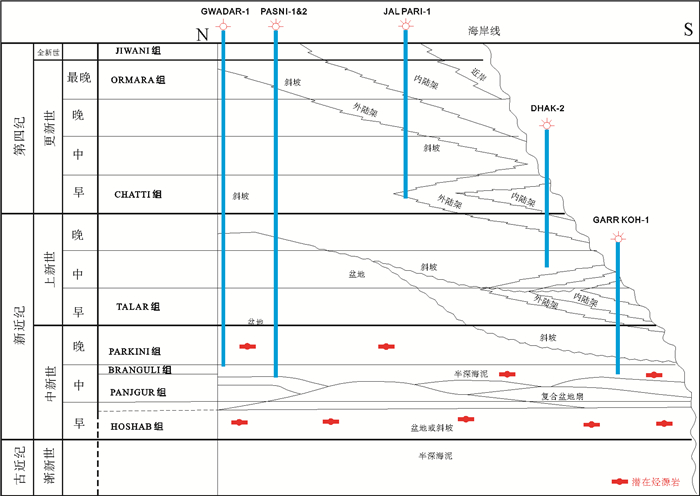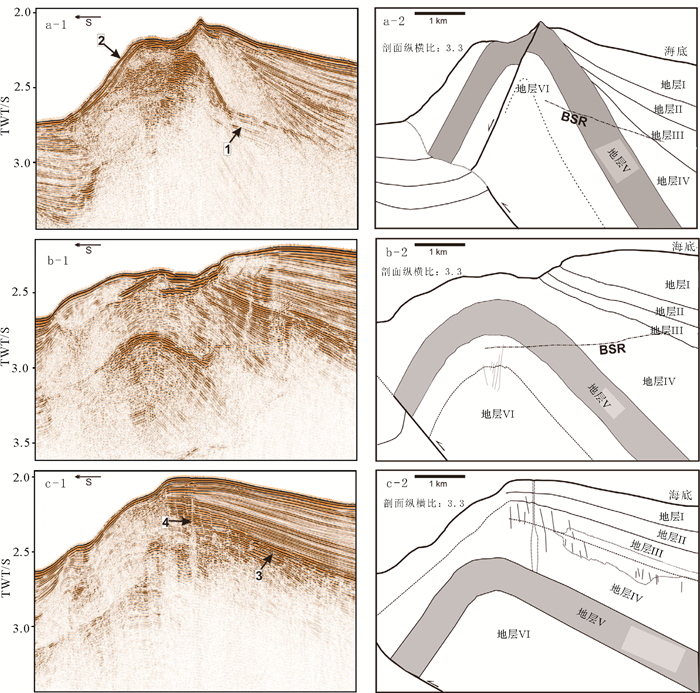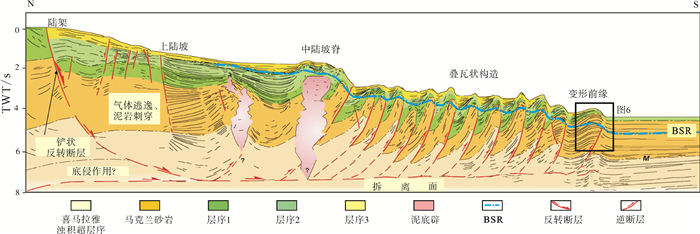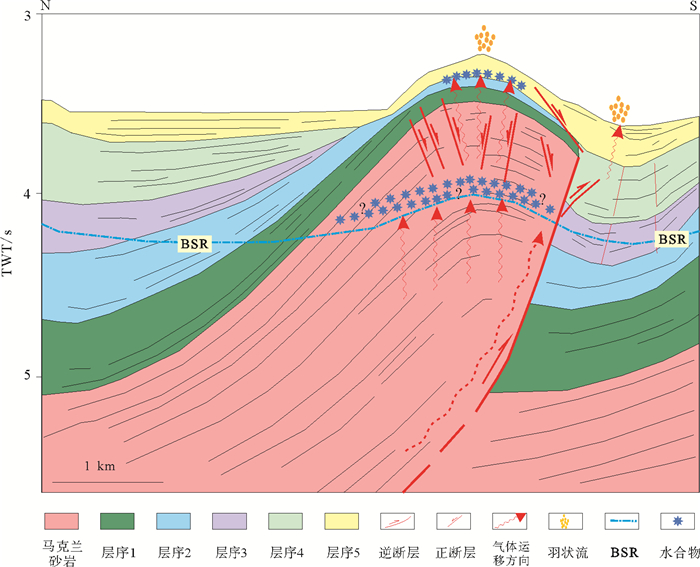Gas hydrate accumulation models of Makran accretionary wedge, northern Indian Ocean
-
摘要: 印度洋北部马克兰增生楔是阿拉伯板块低角度俯冲到欧亚板块之下形成的,平面上具有北部沉积速率高,沉积厚度大,南部逆冲断裂和紧闭褶皱发育,且构造活动具有北部拉张与南部挤压的特征;纵向上具有深部断裂活动强与浅部构造相对稳定的特点。这种复杂的活动大陆边缘具有世界上超低的俯冲角度和良好的水合物成藏条件,因此,平面上水合物矿藏类型多样,其中,下陆坡和增生楔前缘主要受叠瓦状逆冲断层的控制而形成“阶梯式增生楔型”水合物藏,而中陆坡和上陆坡主要受沉积厚度和北部拉张的控制作用而形成“底辟型”和“泥火山型”水合物藏。纵向上马克兰增生楔水合物矿藏具有“二层楼结构”的成藏模式,即深部主要受逆冲断层的控制,而浅部主要受正断层的控制。上述成藏模式可能与阿拉伯板块低角度俯冲有关。Abstract: The Makran accretionary wedge, located in the northern Indian Ocean, is resulted from the subduction of the Arabian plate under the Eurasian plate at a low dip angle. In the northern part of the accretionary wedge, sedimentation rate is high and sediments are thick, while in the southern part, thrust faults and tight anticlines dominate. The tectonics is characterized by extension in north and compression in south. In vertical direction, however, faulting activities are strong in the deep and weak in the shallow part. It is a complicated active continental margin characterized by an ultralow angle subduction plate in the world and thus has good conditions for hydrate accumulation. So far, different types of hydrate accumulations have been found. The hydrate accumulation of multi-stepped accretionary wedges mainly occur in the Lower-Slope and Deformation Front under the control of imbricate thrust faults, while the hydrate accumulation of mud diapirs and mud volcanoes types mainly occur in the Mid-Slope and Upper-Slope, which are jointly controlled by sediment thickness and the tectonic tension in the north. Vertically, the hydrate accumulations are characterized by so called "Double floor structure". It means that deep accumulations are mainly controlled by thrust faults, while shallow ones are mainly under the control of normal faults. The above-mentioned hydrate accumulation models may owe their origin to the low angle subduction of the Arabian Plate towards the Eurasian Plate.
-
全球天然气水合物调查研究结果显示,天然气水合物主要分布在主动大陆边缘的增生楔和被动大陆边缘的陆坡、岛坡、滨外海底与海山、边缘盆地[1](图 1),其中,增生楔上的断裂和褶皱、滑塌体、泥底辟、泥火山等特殊地质体与水合物有着密切的关系。位于主动大陆边缘的增生楔沉积物厚度大,断层和褶皱发育,有利于流体的运移与聚集,可以形成大范围的水合物分布区。而被动大陆边缘由于沉积物的塑性滑动、泥火山活动等常常在海底浅表层形成断裂-褶曲、底辟和海底滑坡等多种构造,也可以为天然气水合物的形成和赋存提供理想场所[2, 3]。
1. 地质背景
印度洋北部马克兰增生楔是阿拉伯板块低角度俯冲到欧亚板块之下形成的(俯冲角度<3°),其上沉积厚度可达7000m以上[4, 5]。前人研究认为,马克兰增生楔是世界上俯冲角度最低的活动大陆边缘,几乎不存在海沟。增生楔上叠瓦状逆冲断层、泥底辟、泥火山、气烟囱等发育,水合物主要分布在水深大于800~3000m的深海。马克兰增生楔由狭窄的陆架(宽10~15km)、宽阔的陆坡以及变形前缘构成。其中,陆坡又由3个地貌单元组成,分别是由紧闭背斜脊和背驮式盆地组成的下陆坡[6-9]、地形平坦的中陆坡、以及气泡羽状流和近岸泥火山较多的上陆坡组成。马克兰增生楔东西向背斜脊有7个,最年轻的为最南边的初生脊(Nascent ridge),脊与脊之间为背驮式盆地(图 2)。
从钻井和地震资料解释得出的上陆坡地层柱状图可以看出(图 3),上陆坡主要由新生代地层组成[10],其中,古近纪的深海泥和中新世的半深海泥既是潜在的烃源岩,也是近岸泥火山喷发的物质基础。
受阿拉伯板块北向俯冲和阿拉伯海东部NE—SW向走滑断层的共同影响(图 2),马克兰增生楔的断裂活动具有南强北弱,深部强浅部弱的特征。具体表现在:E—W向相互平行的向南逆冲的断裂具有由北向南不断增强的趋势,即从不活动到间歇性活动到长期活动[11, 12]。同时,马克兰增生楔东西两侧构造活动也具有较大的差异。从海底地形来看,不论是初生脊还是第一脊,它们都表现为西高东低,初生脊往东甚至消失。从背斜脊的数量、高度、紧闭程度以及背斜脊上正断层和BSR的发育情况来看(图 4),从西到东,背斜脊由紧密到宽缓,背斜高度和数量逐渐降低,BSR和正断层数量减少[13, 14]。上述事实说明马克兰增生楔的构造活动具有西强东弱的特点。纵向上,逆冲断层主要形成于晚中新世-早上新世,活动时间早,活动性强,而浅部的正断层主要形成于晚上新世以来,活动时间晚,活动性弱[4]。
![]() 箭头1:3层BSR;箭头2:第六脊滑塌;箭头3:振幅增强体(亮点);箭头4:第六脊下面的气烟囱Figure 4. Seismic profiles across the sixth ridge (see Figure 2 for location of the three profiles) (after reference [13])Arrow 1: triple BSRs; Arrow 2: collapsed frontal slope of the Sixth Ridge; Arrow 3: high amplitude reflections (bright spots) in Unit Ⅲ; Arrow 4:chimney-like structures in the subsurface beneath the Sixth Ridge
箭头1:3层BSR;箭头2:第六脊滑塌;箭头3:振幅增强体(亮点);箭头4:第六脊下面的气烟囱Figure 4. Seismic profiles across the sixth ridge (see Figure 2 for location of the three profiles) (after reference [13])Arrow 1: triple BSRs; Arrow 2: collapsed frontal slope of the Sixth Ridge; Arrow 3: high amplitude reflections (bright spots) in Unit Ⅲ; Arrow 4:chimney-like structures in the subsurface beneath the Sixth Ridge马克兰增生楔羽状流发育,水深从小于200m到2850m均有分布,羽状流的高度变化为50~1800m,其中,位于初生脊之上的5号站位羽状流高度最大,达到1800m,而2号和7号站位羽状流高度也分别达170m和850m[15]。目前已发现的羽状流站位有15个(流星号报告),通过ROV已在羽状流站位发现了大量与水合物有关的自养生物群落(表 1),其中,2号站位采集到了水合物样品。
表 1 巴基斯坦马克兰增生楔羽状流站位特征(据文献[15])Table 1. The features of flame stations in Makran accretionary wedge (after reference [15])站位 经纬度 水深/m ROV观察结果 备注 1 24°53.49′N、63°01.47′E 552 存在白色和桔黄色菌席,白色菌席之下为黑色硫化物。在一个较小的区域(30~50m2)发现十几个渗漏点,气泡从海底渗漏。 羽状流高100~150m 2 24°50.80′N、63°01.44′E 1025 菌席、管状蠕虫、气泡。菌席分布广,密度高,颜色多样,从白色、粉红色、亮黄色均有。碳酸盐岩结壳 滑塌顶,获得水合物。羽状流高170m 3 24°37.27′N、63°02.62′E 1552 大型活体棕色蛤蜊、几个大型螃蟹表明最近在渗漏。ROV故障,否则会有更多发现 无羽状流 4 24°17.91′N、62°50.41′E 1946 蛤蜊、虾、菌席局部,钙质管、流体喷口 第一脊,羽状流高450m 6 24°34.97′N、62°56.30′E 1600 发现了蛤蜊、菌席、碳酸盐岩结壳 羽状流高900m 7 24°38.64′N、62°44.26′E 1632 管状蠕虫、海绵、鱼、螃蟹、高密度棕色贻贝(可用网兜取样)、2个气泡羽状流(高度50cm不等)、死亡的蛤蜊、碳酸盐岩结壳。 羽状流高度850m 11 24°44.52′N、62°58.64′E 1465 碳酸盐岩结壳上覆盖大量贻贝,大量白色螃蟹覆盖贻贝,观察到气泡和蛤蜊。 羽状流高100~150m 15 24°48.41′N、63°59.65′E 733 蛤蜊、虾、圆形菌席很软,边为白色,中间为黄色,钙质管、流体喷口。 羽状流高100m 阿拉伯海深海平原存在大量的泥底辟,在地震测线SO122-04上[16],深海平原(水深约3000m)存在一个埋藏的泥火山,高约120m,直径小于2200m,位于海底之下420m。泥火山的分布明显受断裂系统的控制。考虑到底水温度和地温梯度,马克兰增生楔水合物稳定存在的水深应大于800m。下陆坡水合物作为盖层阻挡了地下流体向海底的运送,因此,缺少羽状流和泥火山。
2. 马克兰增生楔水合物成藏模式
前已述及,马克兰增生楔处于三大板块的交汇处,沉积厚度大,泥火山和羽状流分布广,逆冲断层、紧闭背斜、泥火山、泥底辟等为天然气的运移和聚集提供了场所,有利于天然气水合物的成藏[17]。综合分析认为,马克兰增生楔水合物成藏模式在纵向上具有“二层楼结构”,而平面上成藏模式类型多样:南部的“阶梯式增生楔型”,中部和北部的“底辟型”和“泥火山型”。
2.1 阶梯式增生楔型
统计结果显示[2, 18],主动大陆边缘的增生楔是天然气水合物赋存的重要场所。在主动大陆边缘,随着大洋板块俯冲到大陆板块之下,深海或半深海沉积物在增生楔不断堆积,构造压力不断增加,进而形成一系列的叠瓦状逆冲断层。当增生楔之下富含甲烷的流体沿断层或泥火山向上运移到水合物稳定带中就可以形成增生楔型水合物。通常,增生楔型水合物的BSR清晰连续,分布广,埋藏较浅,横切逆冲断层,振幅空白带较明显[18]。但是,对于马克兰增生楔来讲,大部分逆冲断层位于BSR之下(图 5)。与逆冲断层相伴的是多个不对称的紧闭背斜,其上往往发育正断层。在马克兰增生楔,深部的逆冲断层和浅部的正断层共同构成了流体运移的网络通道,为该区海底羽状流、海底化能自养生物以及水合物的形成和聚集提供了条件[15, 19-21]。为此,我们称这种类型的水合物模式为阶梯式增生楔型(图 6)。目前,浅表层的水合物已取得实物样品[15],而紧邻BSR之上的水合物尚待证实。
2.2 底辟型或泥火山型
前已述及,马克兰增生楔沉积地层最厚可达7000m以上,古近纪和中新世沉积了很厚的深海或半深海泥岩,它们为该区泥底辟或泥火山提供了物质基础(图 3)。马克兰增生楔泥底辟主要分布在中陆坡,下陆坡和变形前缘也有少量分布。由于资料有限,对于该区与泥底辟有关的水合物藏的分布尚不清楚,但从全球泥底辟型或泥火山型水合物成藏模式来看[22-24],其水合物常常围绕泥底辟构造或泥火山呈环带状分布。在伊朗马克兰增生楔的中陆坡,泥底辟上部可见清晰的BSR(图 5),BSR的埋藏深度与该区阶梯式增生楔型水合物的埋深相近。巴基斯坦海域已发现与水合物有关的羽状流站位15处(表 1),但其下是否存在泥底辟或断层尚不清楚,需要进一步工作。
马克兰陆域增生楔共发现泥火山55处,其中,巴基斯坦近岸发育大小泥火山53处,伊朗近岸发育2处。海域共发现22处泥火山/泥底辟,其中巴基斯坦海域14处,伊朗海域6处。地震剖面显示(图 5),中陆坡有大量的与逆冲断层有关的泥底辟。绝大多数泥火山沿背斜走向分布,并在脊部喷出[25]。近岸泥火山由于水深太浅,难以形成水合物,因此,推测少量的泥火山型水合物可能主要分布在下陆坡和变形前缘向海一侧[8, 26-28]。
3. 讨论
从气孔状水合物样品、众多羽状流站位及其与水合物有关的生物群落等来看[15],马克兰增生楔具备天然气水合物形成的良好条件。但是,马克兰增生楔与全球其他主动大陆边缘的增生楔相比具有特殊性,即增生楔宽度大、沉积厚度大、板块俯冲角度低,同时具有某些被动大陆边缘的特征。具体表现在:其下陆坡和变形前缘的逆冲断层活动性从深部向浅部减弱,逆冲断层通常终止在海底之下的地层中,其上通常发育小型正断层,它们协同起到流体运移通道的作用。因此,马克兰增生楔的水合物成藏模式在时间上和空间上与其他主动大陆边缘有较大差异。纵向上主要表现为“二层楼结构”:深部主要受逆冲断层控制,而浅部主要受正断层控制。平面上成藏模式多样:下陆坡和增生楔前缘由于主要受逆冲断层的控制,水合物成藏模式以阶梯式增生楔型水合物为主;而中陆坡和上陆坡由于主要受沉积物厚度和构造拉张作用的影响,其水合物成藏模式以泥底辟或泥火山型水合物为主。相对而言,阶梯式增生楔型水合物矿藏可能具有更高的水合物饱和度和更明显的水合物地球物理特征。
马克兰增生楔水合物矿藏的另一个特点是部分海区存在多层BSR现象。双BSR现象既可以出现在被动大陆边缘地区,例如Storegge滑塌区,解释认为双BSR是第2次滑塌造成的;也可以出现在主动大陆边缘,例如日本南海海槽,其形成原因不清[17],可能的解释为构造抬升、海平面下降或海底水温升高所致。马克兰增生楔在穿过第六脊的三条南北向地震剖面上(图 2、图 4),从西到东,BSR的数量从3个到1个,到最东边消失不见。马克兰增生楔多层BSR反射是滑塌造成的还是构造抬升造成的目前尚不清楚,是否体现了某些被动大陆边缘的特征目前也不清楚。
4. 结论
(1) 马克兰增生楔平面上具有“南挤北张”、纵向上具有“深部逆冲断裂强而早,浅部拉张断裂弱而晚”的构造演化特征。根据多层BSR反射和较为发育的泥底辟或泥火山推测马克兰增生楔具有某些被动大陆边缘的特征。
(2) 阶梯式断层为马克兰增生楔水合物的形成提供了通道。马克兰增生楔深部的逆冲断层和浅部的正断层共同构成了流体运移的网络通道,为该区海底羽状流、海底化能自养生物以及水合物藏提供了条件,形成了阶梯式增生楔型的水合物矿藏。
(3) 马克兰增生楔水合物矿藏纵向上具有“二层楼结构”的成藏模式,即深部主要受逆冲断层的控制,而浅部主要受正断层的控制;平面上水合物成藏模式类型多样,下陆坡和增生楔前缘主要为“阶梯式增生楔型”水合物矿藏,而中陆坡和上陆坡主要为“泥底辟型”或“泥火山型”水合物矿藏。
(4) 综合分析认为,受深部逆冲断层控制的下陆坡和增生楔前缘的“阶梯式增生楔型”水合物矿藏饱和度可能更高。
-
图 4 垂直第六脊的3条地震剖面及解释剖面(测线位置见图 2)(据文献[13])
箭头1:3层BSR;箭头2:第六脊滑塌;箭头3:振幅增强体(亮点);箭头4:第六脊下面的气烟囱
Figure 4. Seismic profiles across the sixth ridge (see Figure 2 for location of the three profiles) (after reference [13])
Arrow 1: triple BSRs; Arrow 2: collapsed frontal slope of the Sixth Ridge; Arrow 3: high amplitude reflections (bright spots) in Unit Ⅲ; Arrow 4:chimney-like structures in the subsurface beneath the Sixth Ridge
表 1 巴基斯坦马克兰增生楔羽状流站位特征(据文献[15])
Table 1 The features of flame stations in Makran accretionary wedge (after reference [15])
站位 经纬度 水深/m ROV观察结果 备注 1 24°53.49′N、63°01.47′E 552 存在白色和桔黄色菌席,白色菌席之下为黑色硫化物。在一个较小的区域(30~50m2)发现十几个渗漏点,气泡从海底渗漏。 羽状流高100~150m 2 24°50.80′N、63°01.44′E 1025 菌席、管状蠕虫、气泡。菌席分布广,密度高,颜色多样,从白色、粉红色、亮黄色均有。碳酸盐岩结壳 滑塌顶,获得水合物。羽状流高170m 3 24°37.27′N、63°02.62′E 1552 大型活体棕色蛤蜊、几个大型螃蟹表明最近在渗漏。ROV故障,否则会有更多发现 无羽状流 4 24°17.91′N、62°50.41′E 1946 蛤蜊、虾、菌席局部,钙质管、流体喷口 第一脊,羽状流高450m 6 24°34.97′N、62°56.30′E 1600 发现了蛤蜊、菌席、碳酸盐岩结壳 羽状流高900m 7 24°38.64′N、62°44.26′E 1632 管状蠕虫、海绵、鱼、螃蟹、高密度棕色贻贝(可用网兜取样)、2个气泡羽状流(高度50cm不等)、死亡的蛤蜊、碳酸盐岩结壳。 羽状流高度850m 11 24°44.52′N、62°58.64′E 1465 碳酸盐岩结壳上覆盖大量贻贝,大量白色螃蟹覆盖贻贝,观察到气泡和蛤蜊。 羽状流高100~150m 15 24°48.41′N、63°59.65′E 733 蛤蜊、虾、圆形菌席很软,边为白色,中间为黄色,钙质管、流体喷口。 羽状流高100m -
[1] 王健, 邱文弦, 赵俐红.天然气水合物发育的构造背景分析[J].地质科技情报, 2010, 29(2): 100-106. doi: 10.3969/j.issn.1000-7849.2010.02.018 WANG Jian, QIU Wenxian, ZHAO Lihong. Tectonic settings analysis of gas hydrate deposits development[J]. Geological Science and Technology Information, 2010, 29(2): 100-106. doi: 10.3969/j.issn.1000-7849.2010.02.018
[2] 张光学, 祝有海, 梁金强, 等.构造控制型天然气水合物矿藏及其特征[J].现代地质, 2006, 20(4): 605-612. doi: 10.3969/j.issn.1000-8527.2006.04.012 ZHANG Guangxue, ZHU Youhai, LIANG Jinqiang, et al. Tectonic controls on gas hydrate deposits and their characteristics[J]. Geoscience, 2006, 20(4): 605-612. doi: 10.3969/j.issn.1000-8527.2006.04.012
[3] 张光学, 祝有海, 徐华宁.非活动大陆边缘的天然气水合物及其成藏过程述评[J].地质论评, 2003, 49(2): 181-186. doi: 10.3321/j.issn:0371-5736.2003.02.010 ZHANG Guangxue, ZHU Youhai, XU Huaning. Gas hydrate on the passive continental margin and its pool-formation process[J]. Geological Review, 2003, 49(2): 181-186. doi: 10.3321/j.issn:0371-5736.2003.02.010
[4] Grando G, McClay K. Morphotectonics domains and structural styles in the Makran accretionary prism, offshore Iran[J]. Sedimentary Geology, 2007, 196(1-4): 157-179. doi: 10.1016/j.sedgeo.2006.05.030
[5] Kopp C, Fruehn J, Flueh E R, et al. Structure of the Makran subduction zone from wide-angle and reflection seismic data[J]. Tectonophysics, 2000, 329(1-4): 171-191. doi: 10.1016/S0040-1951(00)00195-5
[6] White R S, Louden K E. The Makran continental margin: structure of a thickly sedimented convergent plate boundary[M]//Watkins J S, Drake C L. Studies in Continental Margin Geology. Tulsa, Okla: American Association of Petroleum Geologists, 1983: 499-518.
[7] Flueh E R, Kukowski N, Reichert C. RV sonne, cruise report SO123 'MAMUT' (Makran Murray Traverse)[R]. GEOMAR Report. 1997, 62: 291.
[8] Kukowski N, Schillhorn T, Huhn K, et al. Morphotectonics and mechanics of the central Makran accretionary wedge off Pakistan[J]. Marine Geology, 2001, 173(1-4): 1-19. doi: 10.1016/S0025-3227(00)00167-5
[9] Ellouz-Zimmermann N, Lallemant S J, Castilla R, et al. Offshore frontal part of the Makran accretionary prism: The Chamak Survey (Pakistan)[M]//Lacombe O, Roure F, Lavé J, et al. Thrust Belts and Foreland Basins. Berlin: Springer, 2007: 351-366.
[10] Hussain A, Khan M R, Ahmad N, et al. Mud-diapirism induced structuration and implications for the definition and mapping of hydrocarbon traps in Makran accretionary prism, Pakistan[C]//AAPG/SEG International Conference & Exhibition, Melbourne. Melbourne, Australia: SEG, 2015: 13-16.
[11] Smith G L. The structure, fluid distribution and earthquake potential of the Makran subduction zone, Pakistan[D]. Southampton, Great Britain: University of Southampton, 2013.
[12] Smith G, McNeill L, Henstock T J, et al. The structure and fault activity of the Makran accretionary prism[J]. Journal of Geophysical Research: Solid Earth, 2012, 117(B7): B07407. http://www.wanfangdata.com.cn/details/detail.do?_type=perio&id=10.1029/2012JB009312
[13] Ding F, Spiess V, Fekete N, et al. Interaction between accretionary thrust faulting and slope sedimentation at the frontal Makran accretionary prism and its implications for hydrocarbon fluid seepage[J]. Journal of Geophysical Research: Solid Earth, 2010, 115(B8): B08106. http://www.wanfangdata.com.cn/details/detail.do?_type=perio&id=10.1029/2008JB006246
[14] Shoar B H, Javaherian A, Farajkhah N K, et al. Reflectivity template, a quantitative intercept-gradient AVO analysis to study gas hydrate resources-a case study of Iranian deep sea sediments[J]. Marine and Petroleum Geology, 2014, 51: 184-196. doi: 10.1016/j.marpetgeo.2013.12.007
[15] Bohrmann G, Bahr A, Brinkmann F, et al. Cold seeps of the Makran subduction zone (Continental Margin of Pakistan): R/V meteor cruise report M74/3: M74, Leg3, Fujairah-Male[R]. Fachbereich Geowissenschaften, Universitat Bremen, 2008.
[16] Von Rad U, Berner U, Delisle G, et al. Gas and fluid venting at the Makran accretionary wedge off Pakistan[J]. Geo-Marine Letters, 2000, 20(1): 10-19. doi: 10.1007/s003670000033
[17] 龚建明, 廖晶, 孙晶, 等.巴基斯坦马克兰增生楔天然气水合物的主控因素[J].海洋地质前沿, 2016, 32(12): 10-15. http://d.old.wanfangdata.com.cn/Periodical/hydzdt201612002 GONG Jianming, LIAO Jing, SUN Jing, et al. Factors controlling gas hydrate accumulation in Makran accretionary wedge off Pakistan[J]. Marine Geology Frontiers, 2016, 32(12): 10-15. http://d.old.wanfangdata.com.cn/Periodical/hydzdt201612002
[18] Baba K, Yamada Y. BSRs and associated reflections as an indicator of gas hydrate and free gas accumulation: An example of accretionary prism and forearc basin system along the Nankai trough, off central Japan[J]. Resource Geology, 2004, 54(1): 11-24. doi: 10.1111-j.1751-3928.2004.tb00183.x/
[19] Römer M, Sahling H, Pape T, et al. Quantification of gas bubble emissions from submarine hydrocarbon seeps at the Makran continental margin (offshore Pakistan)[J]. Journal of Geophysical Research: Oceans, 2012, 117(C10): C10015. http://www.wanfangdata.com.cn/details/detail.do?_type=perio&id=10.1029/2011JC007424
[20] Römer M, Sahling H, Spieβ V, et al. The role of gas bubble emissions at deep-water cold seep systems: An example from the Makran continental margin, offshore Pakistan[C]//Proceedings of the 7th International Conference on Gas Hydrates (ICGH 2011). Edinburgh, Scotland, 2011: 17-21.
[21] Smith G L, McNeill L C, Henstock T J, et al. Fluid generation and distribution in the highest sediment input accretionary margin, the Makran[J]. Earth and Planetary Science Letters, 2014, 403: 131-143. doi: 10.1016/j.epsl.2014.06.030
[22] Milkov A V. Worldwide distribution of submarine mud volcanoes and associated gas hydrates[J]. Marine Geology, 2000, 167(1-2): 29-42. doi: 10.1016/S0025-3227(00)00022-0
[23] Milkov A V, Sassen R. Economic geology of offshore gas hydrate accumulations and provinces[J]. Marine and Petroleum Geology, 2002, 19(1): 1-11. doi: 10.1016/S0264-8172(01)00047-2
[24] 沙志彬, 王宏斌, 张光学, 等.底辟构造与天然气水合物的成矿关系[J].地学前缘, 2005, 12(3): 283-288. doi: 10.3321/j.issn:1005-2321.2005.03.032 SHA Zhibin, WANG Hongbin, ZHANG Guangxue, et al. The relationships between diapir structure and gas hydrate mineralization[J]. Earth Science Frontiers, 2005, 12(3): 283-288. doi: 10.3321/j.issn:1005-2321.2005.03.032
[25] Schlüter H U, Prexl A, Gaedicke C, et al. The Makran accretionary wedge: sediment thicknesses and ages and the origin of mud volcanoes[J]. Marine Geology, 2002, 185(3-4): 219-232. doi: 10.1016/S0025-3227(02)00192-5
[26] Wiedicke M, Neben S, Spiess V. Mud volcanoes at the front of the Makran accretionary complex, Pakistan[J]. Marine Geology, 2001, 172(1-2): 57-73. doi: 10.1016/S0025-3227(00)00127-4
[27] Delisle G. The mud volcanoes of Pakistan[J]. Environmental Geology, 2004, 46(8): 1024-1029. doi: 10.1007/s00254-004-1089-x
[28] Ellouz-Zimmermann N, Lallemant S J, Castilla R, et al. Offshore frontal part of the Makran accretionary prism: the Chamak survey (Pakistan)[M]//Lacombe O, Roure F, Lavé J, et al. Thrust Belts and Foreland Basins. Berlin: Springer, 2017: 349-364.
-
期刊类型引用(12)
1. SHAO Longfei,YU Fusheng,GONG Jianming,LIAO Jing,YU Zhifeng,TANG Liang,CHEN Jiangong,WANG Yuefeng,NENG Yuan. Genetic Analysis of Structural Styles in the Makran Accretionary Wedge–Insight from Physical Simulations. Journal of Ocean University of China. 2024(01): 157-172 .  必应学术
必应学术
2. 傅钰,童思友,贾雪倩,陈江欣. 主动大陆边缘典型地区流体运移体系对天然气水合物成藏的影响研究. 地球物理学进展. 2024(03): 1228-1240 .  百度学术
百度学术
3. 胡高伟,卜庆涛,赵亚鹏,赵文高,王自豪,邱晓倩,刘童. 不同类型水合物成藏特征研究进展. 地质学报. 2024(09): 2557-2578 .  百度学术
百度学术
4. 刘斌,李柯良,邓希光,黄建宇,周大森,郭武. 马克兰俯冲带海域水合物高分辨率地震数据处理及初步成果. 海洋地质前沿. 2022(01): 80-84 .  百度学术
百度学术
5. 李强,杨天邦,庄畅,邓希光,王海峰,于淼. 阿拉伯海北部马克兰增生楔G16站位地球化学特征及其对天然气水合物的指示. 海洋地质与第四纪地质. 2021(03): 161-169 .  本站查看
本站查看
6. Jian-ming Gong,Jing Liao,Yu-xi Zhang,Jie Liang,Jian-wen Chen,Nuzhat Khan,Syed Waseem Haider. Characteristics of major and trace elements in surface sediments of the Makran Accretionary Prism, Pakistan and their implications for natural gas hydrates. China Geology. 2021(02): 299-310 .  必应学术
必应学术
7. 蔡峰,吴能友,闫桂京,李清,梁杰,孙运宝,董刚,骆迪,李昂,王星星. 海洋浅表层天然气水合物成藏特征. 海洋地质前沿. 2020(09): 73-78 .  百度学术
百度学术
8. 卜庆涛,刘圣彪,胡高伟,刘昌岭,万义钊. 含水合物沉积物声学特性——实验模拟与数值模拟的对比分析. 海洋地质前沿. 2020(09): 56-67 .  百度学术
百度学术
9. 陈强,胡高伟,李彦龙,万义钊,刘昌岭,吴能友,刘洋. 海域天然气水合物资源开采新技术展望. 海洋地质前沿. 2020(09): 44-55 .  百度学术
百度学术
10. 耿威,孙治雷,吴能友,曹红,张喜林,王利波,张现荣,徐翠玲,翟滨. 巴伦支海西南部天然气水合物形成与分解影响因素. 海洋地质前沿. 2020(09): 109-120 .  百度学术
百度学术
11. 鲁晓兵,张旭辉,王平康,梁前勇. 天然气水合物成藏动力学研究进展. 中国科学:物理学 力学 天文学. 2019(03): 60-75 .  百度学术
百度学术
12. 李伟,吴昱诚. 南海东沙群岛泥火山矿产预测. 矿产勘查. 2018(08): 1587-1592 .  百度学术
百度学术
其他类型引用(6)




 下载:
下载:







